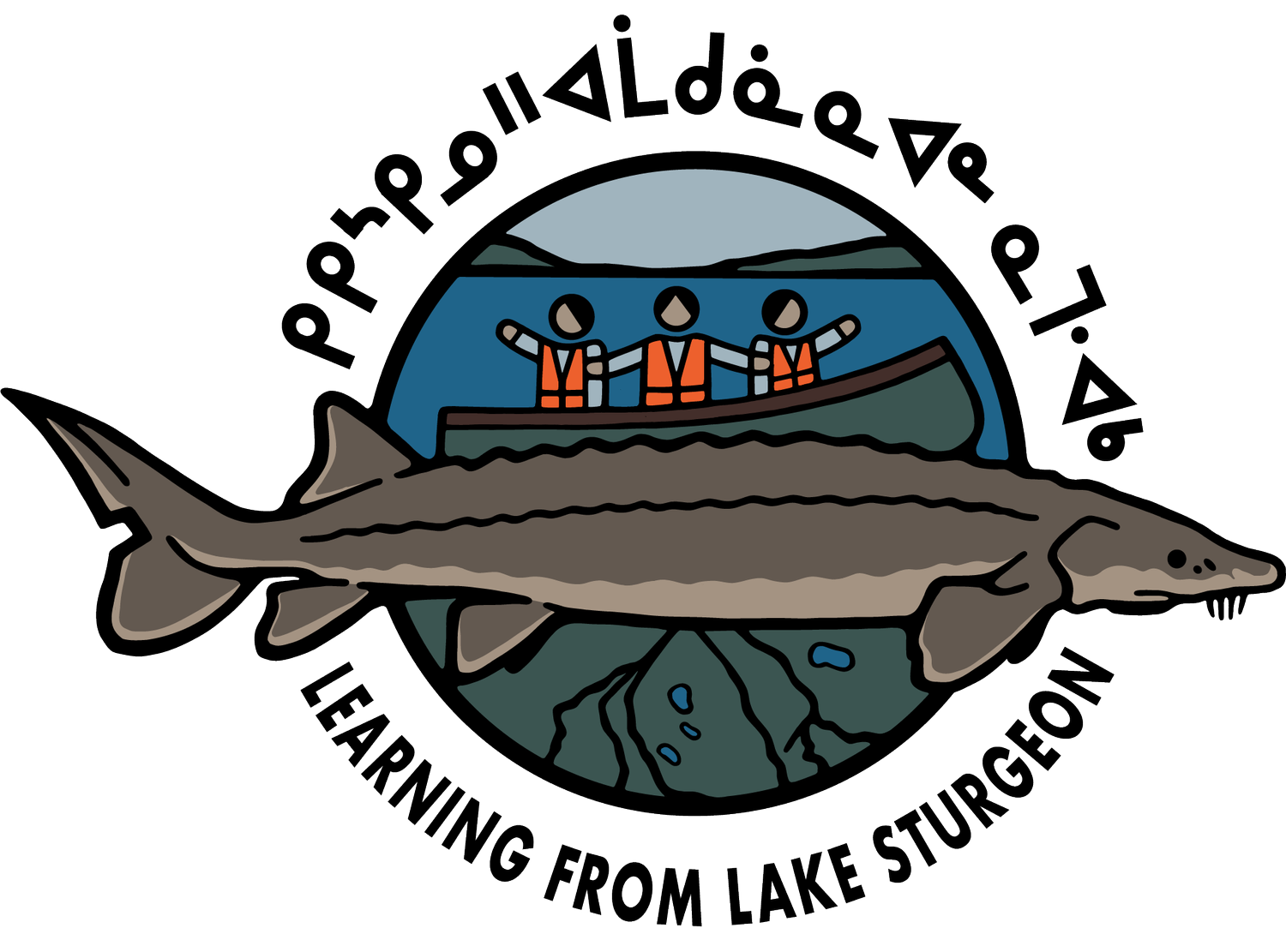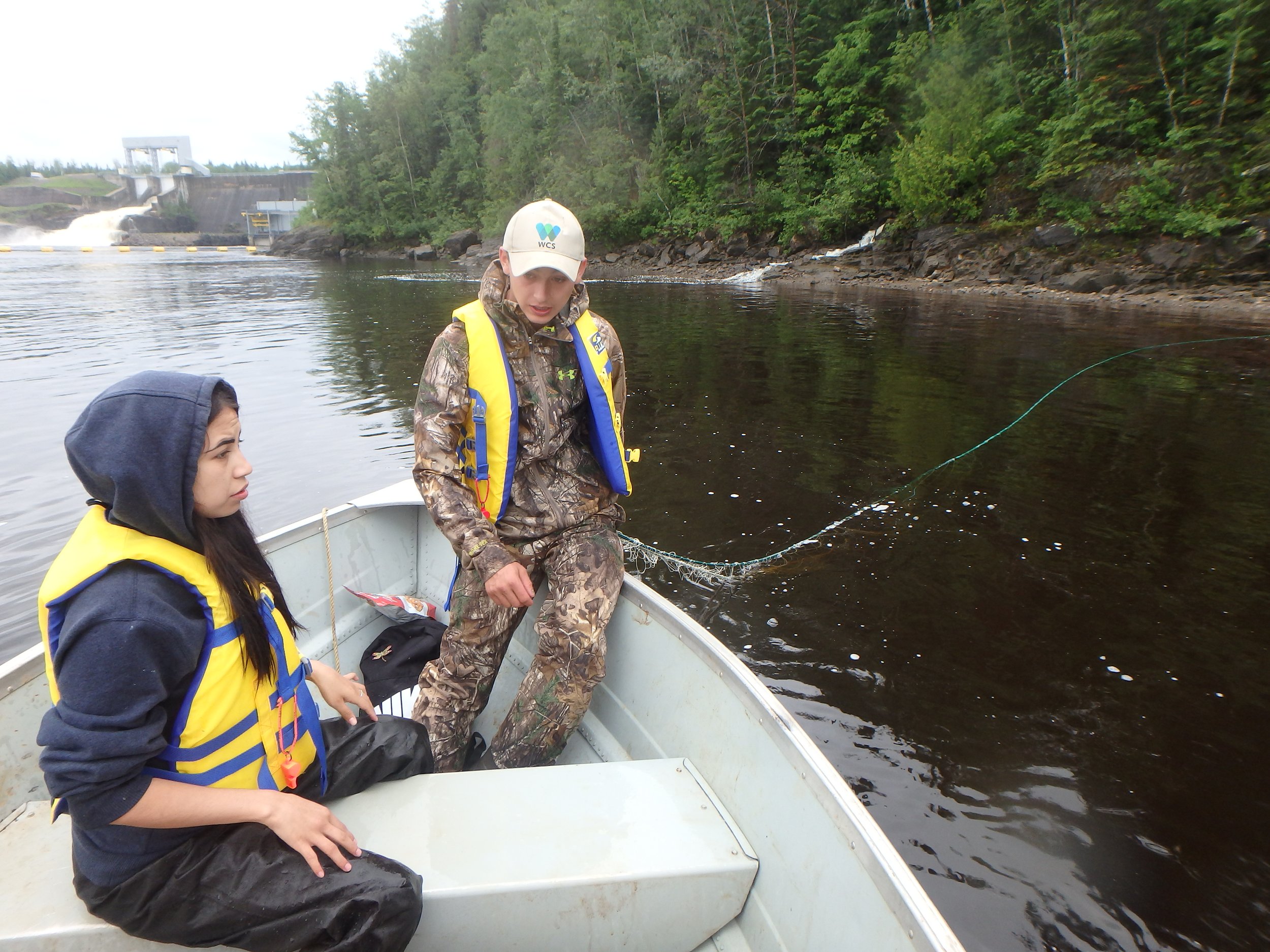CONNECTING WITH RIVERS: REFLECTIONS FROM MOOSE CREE YOUTH
Hear from Moose Cree Youth Ocean Skye Phillips about her experiences since 2019 with the Learning from Lake Sturgeon youth program in her published piece on the WCS Canada Muddy Boots Blog. You can follow (click) this link to see it, or read on below!
Ocean releases a namew (lake sturgeon) back into the water after it was sampled during Learning From Lake Sturgeon fieldwork in 2022
My name is Ocean Phillips. I’m a 20-year-old Moose Cree youth, living in Kapuskasing Ontario. In 2019, I had a chance to join Wildlife Conservation Society Canada (WCSC) scientists and staff from the Moose Cree First Nation Resource Protection Unit (MCFN) to study lake sturgeon in the Moose River watershed in the far north of Ontario.
But then COVID happened and that changed everything for me. During COVID I ended up developing severe anxiety and struggled with being around other people. COVID also meant we could not go back out on the river the following year and the river was a place I could relax and be happy. Fortunately, the leaders of the Learning from Lake Sturgeon program from WCSC and MCFN worked hard to keep youth engaged in other ways during the field research shutdown.
Ocean (3rd from left) stands with other youth during an on-the-land event in 2021 with MCFN lead (Jennifer, 4th from left) and Kapuskasing Friendship Centre (Anne-Marie Leblanc, 4th from right)
When I first joined the project, my friend Denika and I stayed out in the bush for two days with WCS staff. During those two days, we helped the team and learned how to use the equipment, such as temperature loggers that track the water temperature throughout the year. We also got to use a small remote-controlled submarine to try and find one of the underwater receivers that had been lost due to extreme water and sediment changes caused by hydroelectric development on the rivers.
Ocean (left) and Denika (right) in the field with dog JD in 2019 on the Mattagami River
The receivers collect signals from sturgeon that have been implanted with special tags so the scientists can track their movements. When I finally got back on the river with the team last spring, I got a chance to watch them implant a tracker into a fish, which I also got to release back into the water later that day with Dr. Connie O’Connor and Jacob Seguin from WCS. It started with me holding the sturgeon with some special gloves that send electricity through the fish and make it go to sleep. This does not hurt the fish in any way and is actually safer than using anesthetic. This was probably one of the coolest things I have ever done in my life!
Connie O’Connor (WCS, left) puts e-gloves on Ocean (right) during spring 2022 fieldwork. Connie is co-lead of the Learning from Lake Sturgeon program with WCS.
I also got to set up nets with WCS scientist Claire Farrell and Justin Simard – another Moose Cree youth. Some of the nets ended up breaking so the team and I spent a good two hours tying knots to fix the nets so we could go back out on the river and set them again. That’s how it goes when you are working on nature’s rivers.
Ocean (left) and Justin (right) finish setting a net below a hydroelectric dam for the Learning from Lake Sturgeon youth program
It takes a lot for me to go away from home and do these trips to the bush to help with the project. But once I actually get out there, all my anxiety goes away and I just focus on the beautiful landscape of the southern part of the Moose River. The only thing that sort of clouds this experience is seeing the changes the hydroelectric generating stations are making to the environment around them. Often, we are working right below the Kipling hydro dam and it’s crazy to see how a dam can affect so many things around it. The one thing I noticed at Kipling is how fast the water level changes because of the station. The water levels get so low that you can walk across to an island that is in the middle of the river, and so high that you can’t even walk on the shore.
Ocean (left) and Jennifer Simard (right) out in the field. Jennifer is co-lead of the Learning from Lake Sturgeon program with Moose Cree First Nation.
This project has also offered me some other great experiences, including going out with some other Moose Cree youth in the early spring on the Kapuskasing River to do some water quality testing. In August last year, I got to go on a trip to Sudbury and Oshawa with Claire Farrell and Annie-Marie LeBlanc and a group of five other youth. During this trip we went to Laurentian University in Sudbury to look at their environmental facilities and do some activities with insects that live in the water that you can’t really see unless you look closely. We also learned from some of the university students doing different types of research.
Ocean (center) and the whole youth, researchers, and chaperones at Laurentian university for the youth trip in 2022
After that, we traveled down to Oshawa, where we got to meet some really incredible people: Keisha Deoraj and Nina Simmons from the Aquatic Omics Lab at Ontario Tech University. Keisha and Nina took us on a tour of the Ontario Tech University and Durham College. We got to sample mucus from small fish and used microscopes to look at fish eggs up close. After we did the science part of the trip, we headed to a bowling alley and huge arcade and spent time getting to know one another.
Some of the youth group after a fun day at the arcade - Ocean is far right, Claire with the Learning from Lake Sturgeon Team is Center, and Anne-Marie Leblanc with the Kapuskasing Friendship Centre is 2nd from left
Getting to do this type of work makes me feel so good and happy inside -- I have never felt so passionate about something. I love all the opportunities that the different experiences come with. I'm so grateful to Claire Farrell and Jennifer Simard for inviting me to be part of this project back in 2019. If it wasn’t for them, I don’t think I would have found my life passion. I’m looking forward to doing more in the future and once I get my degree to be an environmental technician, I hope to come back to work for my band, hopefully WCS, and most importantly for these amazing rivers.










